Cooker hood purchasing advice: how to choose the right product
- What You Need to Know
- Cooker hoods remove the fumes from water vapor and grease produced during cooking and frying.
- There are two variants: recirculation mode, in which grease and odors are filtered out and the purified air is released back into the room, and exhaust mode, in which the fumes are discharged into the open air.
- Many cooker hoods are capable of both modes.
- The models differ in terms of their circulating power and variety of functions.
- When installing an exhaust model, it is important to follow some safety instructions, for example, regarding the avoidance of a negative pressure effect.
Why buy a cooker hood?
Not only if you are an ambitious hobby cook, you know the problem: after cooking, frying and baking, odors often remain in the room despite ventilation. The main problem here is vapor, i.e. the water vapor that condenses in the air. The vapor is the mist that users perceive when preparing food. In addition to water, this vapor can also contain fats, especially when frying or deep-frying.
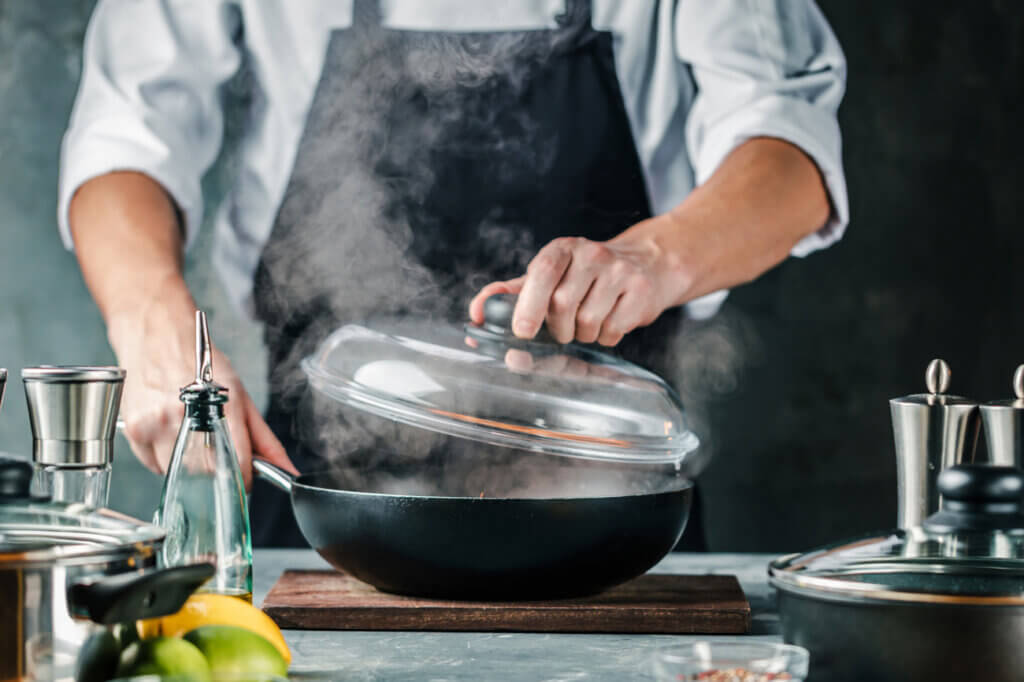
This haze transports cooking and cooking odors into the room, which is unpleasant when frying fish, for example. Furthermore, the humidity settles on walls and ceilings near the cooktop, where it condenses into water. Cooks must regularly catch this moisture by wiping it off with a towel to prevent it from dripping from the kitchen cabinets or running down the wall. In addition to the uncomfortably high humidity in the room, this moisture, if not regularly removed from the room, leads to mold growth. This is unacceptable either in one’s own four walls or in industry. To combat bad odors and excessive humidity in the room, a fume hood, known in the trade as a fume extractor, can help.
Circulating air or exhaust air?
Basically, there are two different types of fume hoods: Recirculating and exhaust models. Recirculating fume hoods extract the fumes, clean the air using filters, and then release it back into the room. In the exhaust versions, the sucked air is transported outside through a pipe. We present the advantages and disadvantages of both systems.
Recirculation: easy installation without structural changes
The cheaper and easier to install variant of the vapor exhaust is the recirculation exhaust hood. In this case, the resulting vapor is sucked by means of a motor into the device, which is mounted in the immediate vicinity of the hob. Inside a recirculation hood there are usually two filters: a metal filter, which removes fats and oils from the air, and an activated carbon filter, which binds unwanted odors for a certain time – usually six to twelve months – so that the air that is returned to the room is free of odors.
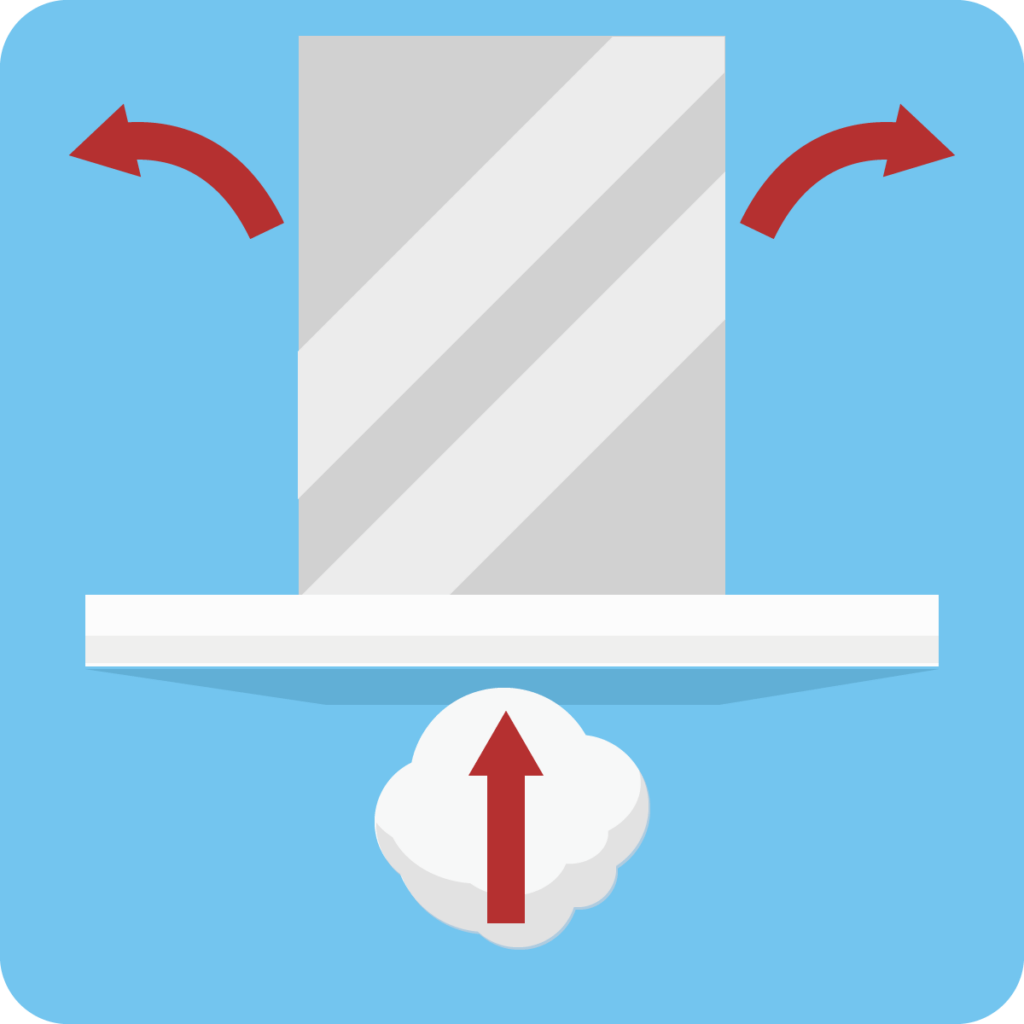
Pro Points
- Easy installation without breaking through the wall
- Can be used regardless of structural conditions
- No heat loss in winter, no heat supply in summer
Drawbacks
- Higher noise level than when using an exhaust hood
- Not as effective at removing odors
- Regular change of the activated carbon filter
- Additional ventilation necessary due to humidity
Exhaust air: effective in removing cooking fumes to the open air
A somewhat more complex variant is the exhaust air hood. Here, odors, oils and grease are not trapped in a filter, instead the fumes are sucked in and transported outside via an exhaust hose. It is true that this variant also has a filter. However, it is not a fleece filter with activated carbon, but a metal grid filter, also called a grease filter or metal filter, which prevents grease and foreign solids from entering the exhaust hose and clogging it. Over time, more and more grease settles on this metal filter, reducing air flow and thus efficiency. Cleaning is necessary after a certain period of use.
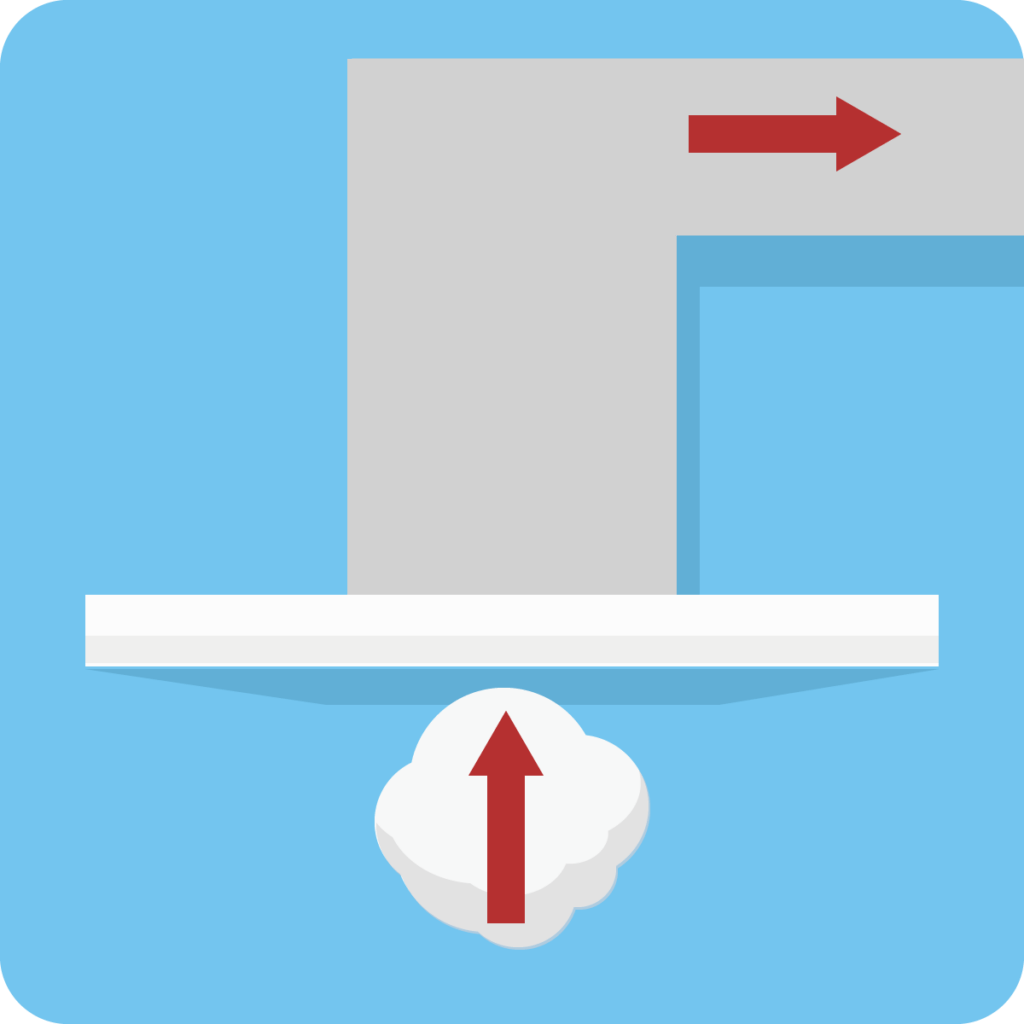
Pro Points
- Transport of moisture to the outside
- No follow-up costs
- Less noise
- Usually higher efficiency
Drawbacks
- Wall penetration required
- Installation effort and costs higher than with the recirculation hood
- Heat loss in winter
Caution negative pressure
When using an exhaust hood, it is important to avoid negative pressure. This occurs when the vapors are conveyed outside via an exhaust hose and users at the same time do not provide for fresh air supply, for example, through an open window. If there is a fireplace, for example a fireplace fire, it quickly becomes dangerous. In this case, toxic fumes can remain in the living space. Therefore, you should always provide ventilation or think about a negative pressure monitor. This can be connected to the cooker hood and switches off the appliance if there is too much negative pressure. In case of doubt, the chimney sweep will advise whether the exhaust air may be discharged via existing chimneys.
Hybrid operation: change at the touch of a button
Some models are suitable for both recirculation and exhaust operation. Users switch between modes at the touch of a button. This allows them to switch to recirculation mode during the cold season to avoid losing heat energy. If a lot of water vapor is produced or a burnt foodstuff causes bad odors, users can direct these undesirable side effects outside at the touch of a button in exhaust air mode.
Different designs
There are many different designs for both recirculation and exhaust hoods, each of which is suitable for different facilities and structural conditions. We present the variety of models below.
Under-cabinet hoods: inexpensive and widely used
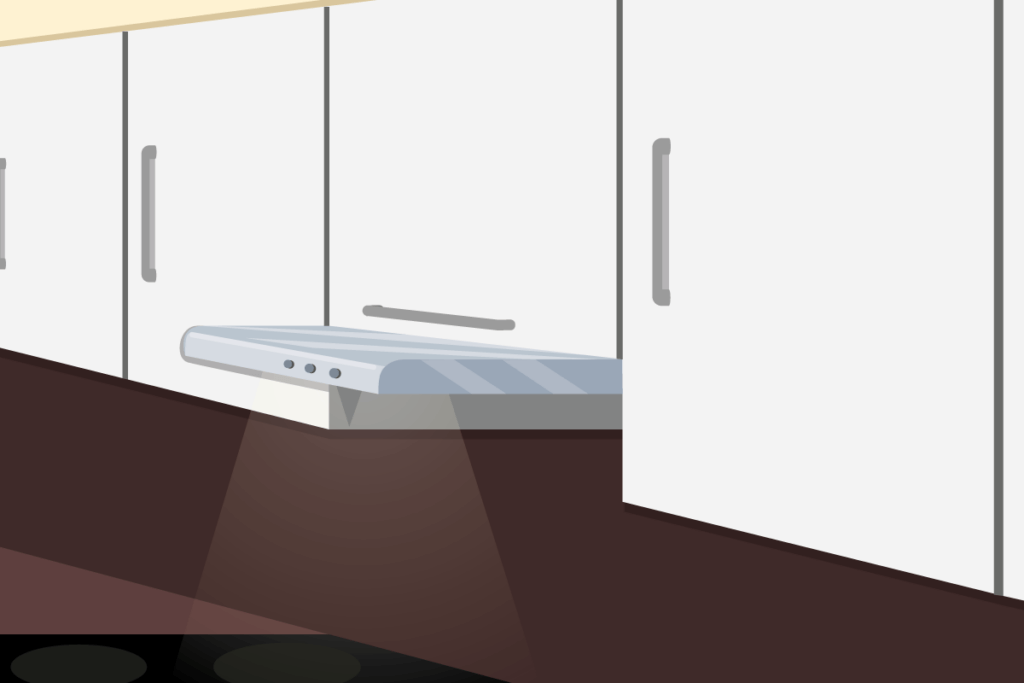
Undercabinet hoods are the most widely used range hood models. They typically have an overall height of 10 to 15 centimeters and are usually mounted under a cabinet. In recirculation mode, under-cabinet hoods blow air back into the room after filtering out grease and odors. In exhaust mode, the exhaust hose is typically routed through the cabinet above. In this case, it is also called a “vapor cabinet”. These models are comparatively inexpensive in their purchase price.
Flat screen hoods: similar to the under-cabinet hoods, for pull-out operation
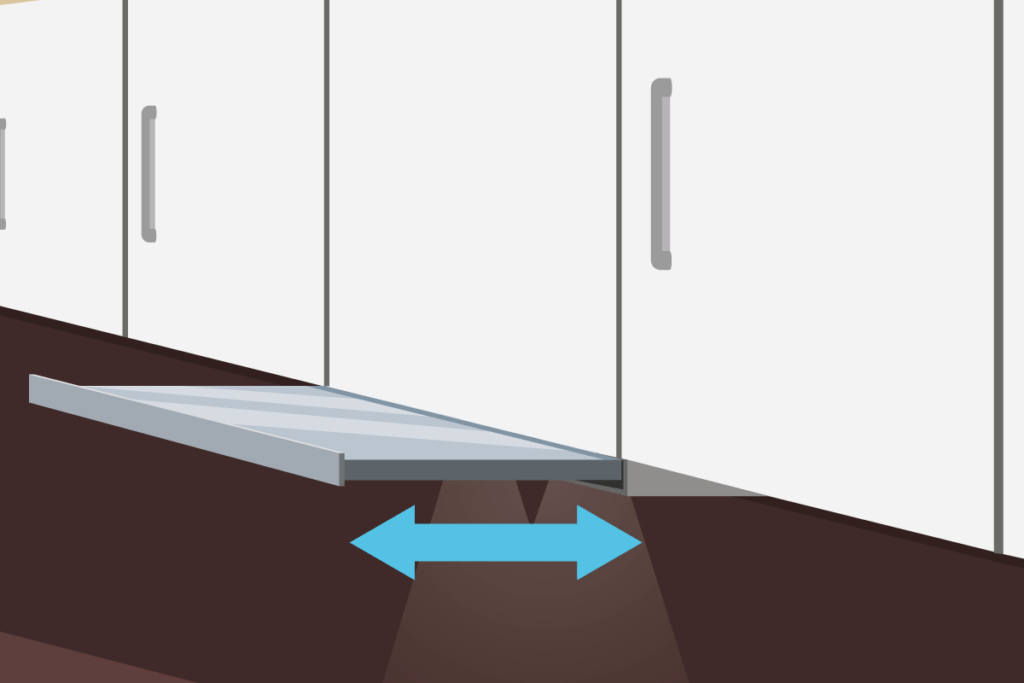
The flat screen hoods are not too different from the under-cabinet hoods. However, flat screen units are more compact because they are extendable. They are convenient because there is less risk of hitting your head. When not needed, they disappear in their entirety under the wall cabinet.
Intermediate hoods: open like a cabinet
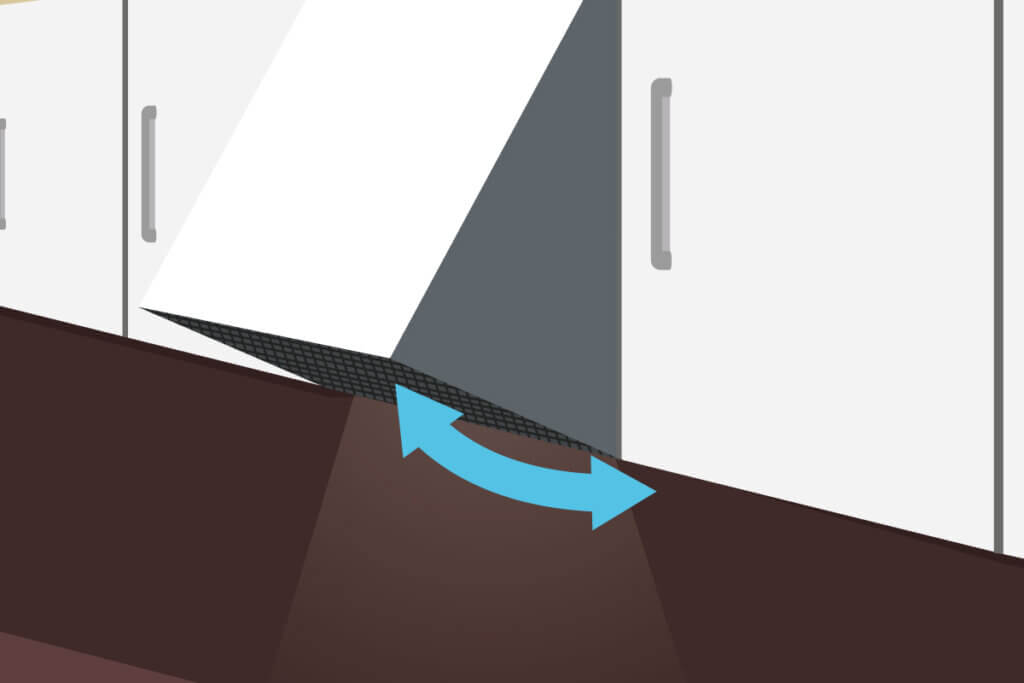
Intermediate hoods are inserted flush into the kitchen furniture and initially remain invisible. When needed, users operate a mechanism reminiscent of a cabinet door that opens upwards. This solution is very discreet and therefore enjoys great popularity.
Ceiling hoods: more suitable for open kitchens
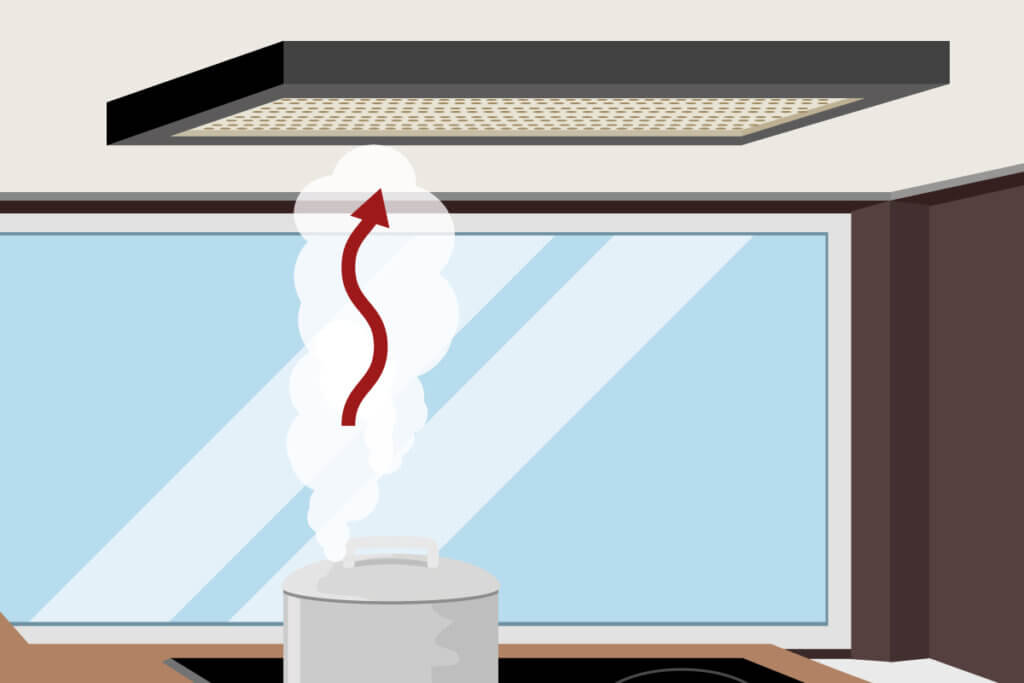
A ceiling hood is primarily intended for installation in open kitchens. It can be installed on the ceiling above the cooking area and also has decorative value. In most cases, they are recirculation hoods, as otherwise a hose would have to be routed through the floor ceiling. In recirculation mode, the purified air is instead blown out the side.
Island hoods: also for open kitchens
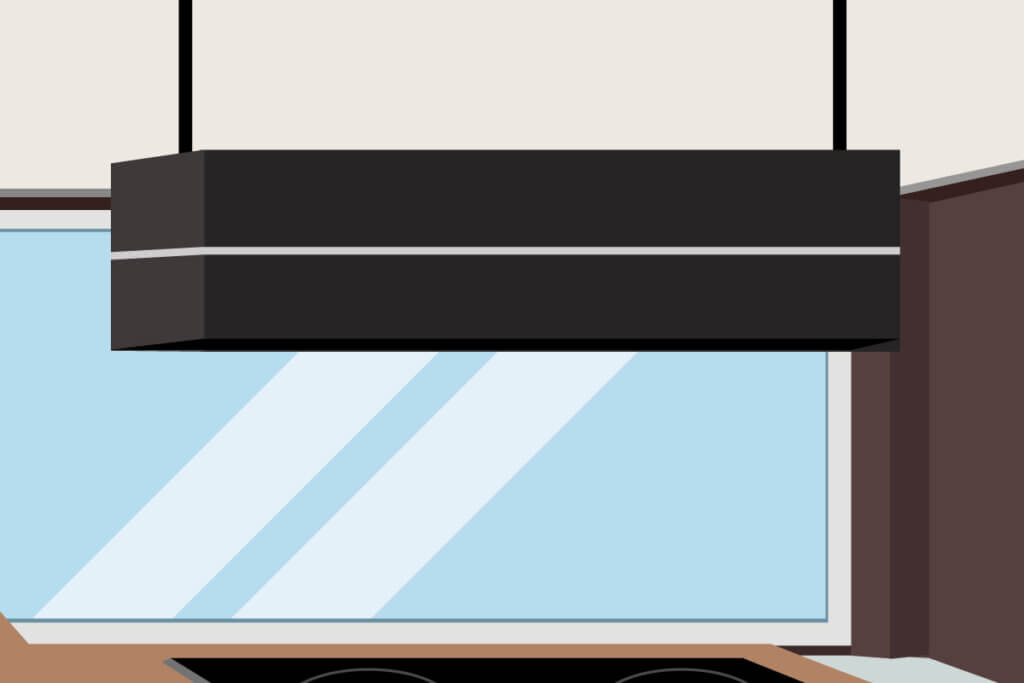
Island hoods, also known as island diners, like ceiling hoods, are range hood models that are particularly suitable for open kitchens with a cooking island in the middle. There are models that can be suspended from the ceiling to the desired location above the cooktop using small wire cables. Since this then eliminates the use of an exhaust hose, these are recirculating air units. Furthermore, there are island hoods that are attached to an exhaust chimney above the cooking island and use the chimney for exhaust air. In some cases, such installation has only decorative value, and the hood still works to recirculate air.
Wall hoods: direct wall mounting without cabinets
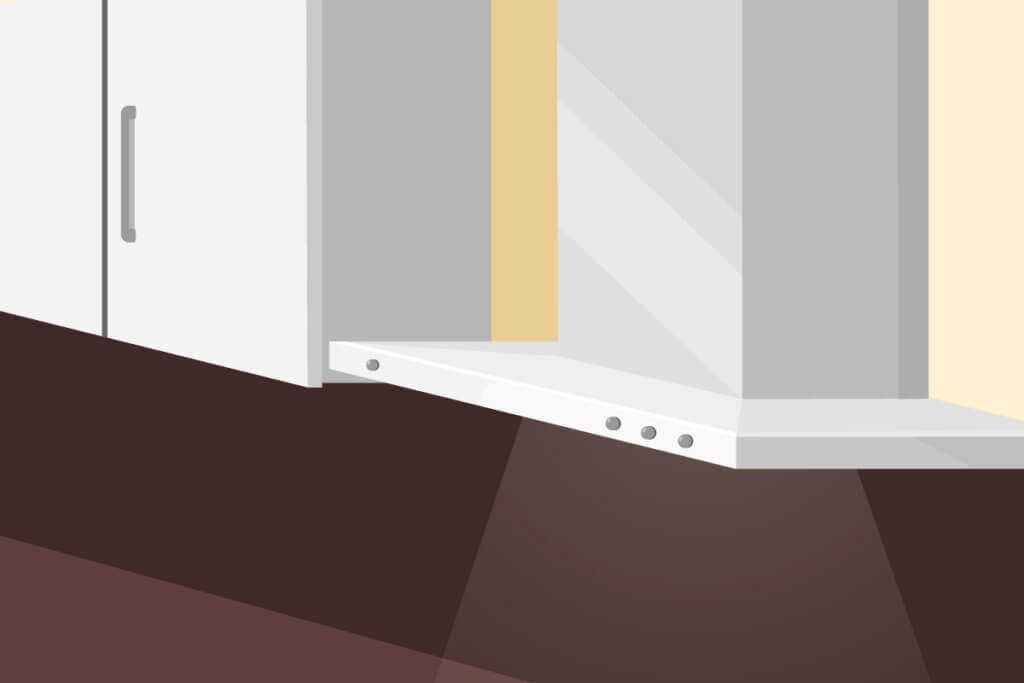
In the case of wall-mounted hoods, also called wall-mounted diners, the installation is carried out directly on the kitchen wall located behind the hob. This type of installation requires that there are no kitchen cabinets above the hob, because this space is needed for mounting. Wall-mounted hoods are available in various designs, for example as angled head-mounted free-standing hoods.
Overhead free-standing hood: more space for cooking thanks to 45-degree arrangement
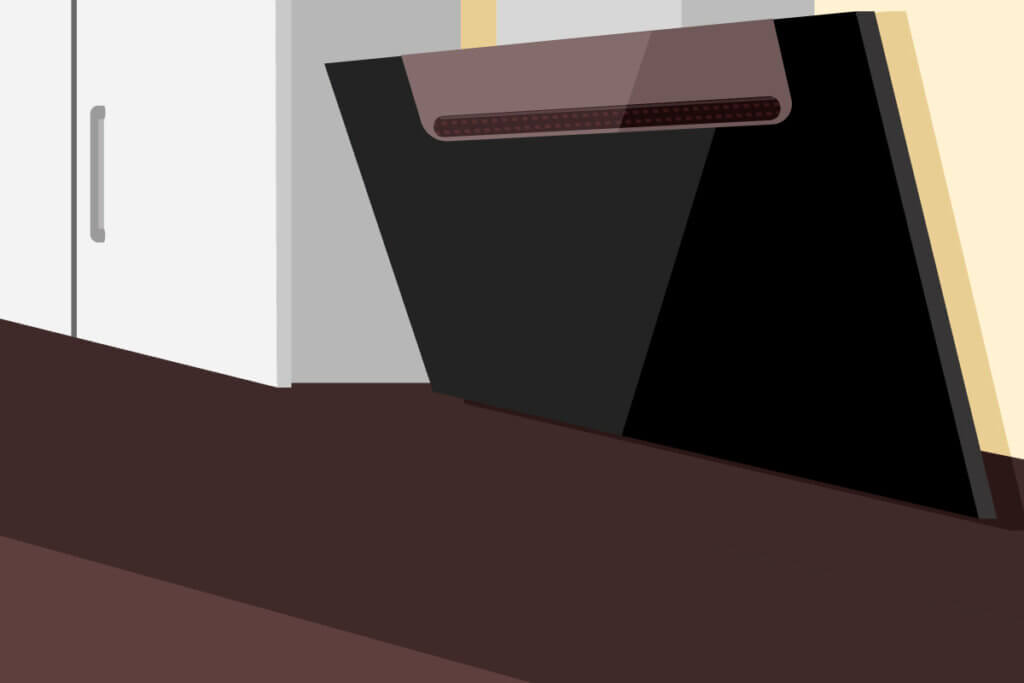
A head-mounted hood is a special type of cooker hood. In these models, for example, the intake screen is mounted at a 45-degree angle so that the user cannot hit his head on it – an advantage especially for taller amateur cooks. Depending on the equipment, these models can be operated in both exhaust and recirculation modes.
Cooktops with extractor hood allow a clear view
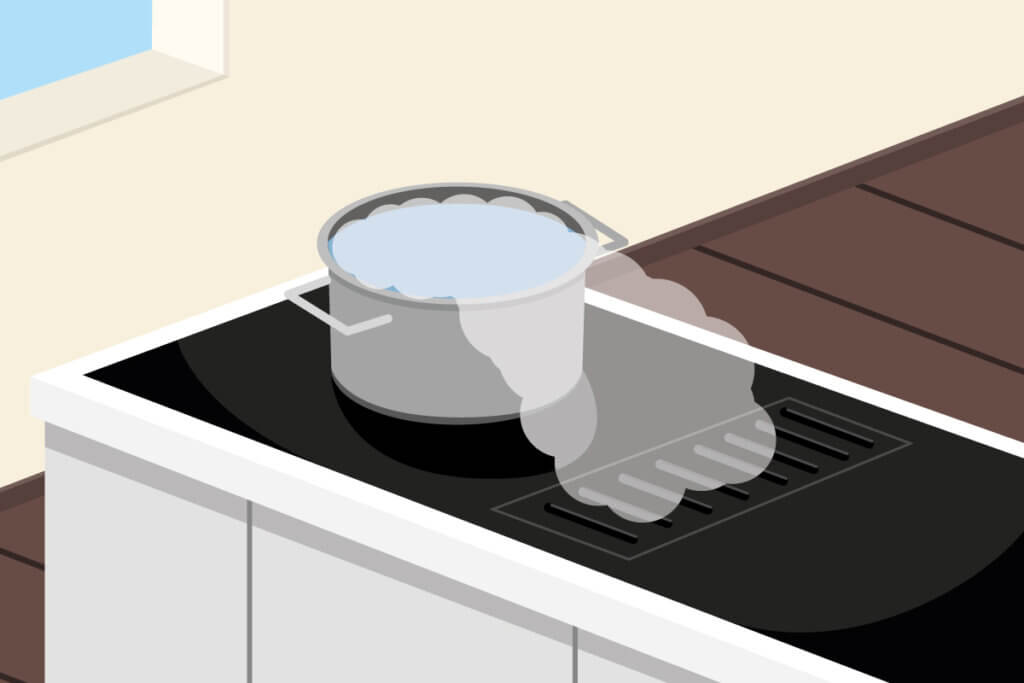
Meanwhile, a comparatively new method of extracting fumes is becoming more and more fashionable: cooktops with integrated extractor fans. Also known as trough fans or down-draft systems, these exhaust solutions suck the fumes downward. One of the advantages is that you have a clear view of pots and pans at all times. This solution offers a great deal of freedom in kitchen planning, as planners are not dependent on whether an existing kitchen cabinet prevents the installation of, say, a wall-mounted hood. For exhaust operation, however, the sideboard under the cooktop must provide enough space for the exhaust hose. These models have fallen significantly in price in recent years and are therefore affordable to a wider mass.
Table fans: perfect adaptation to the respective needs
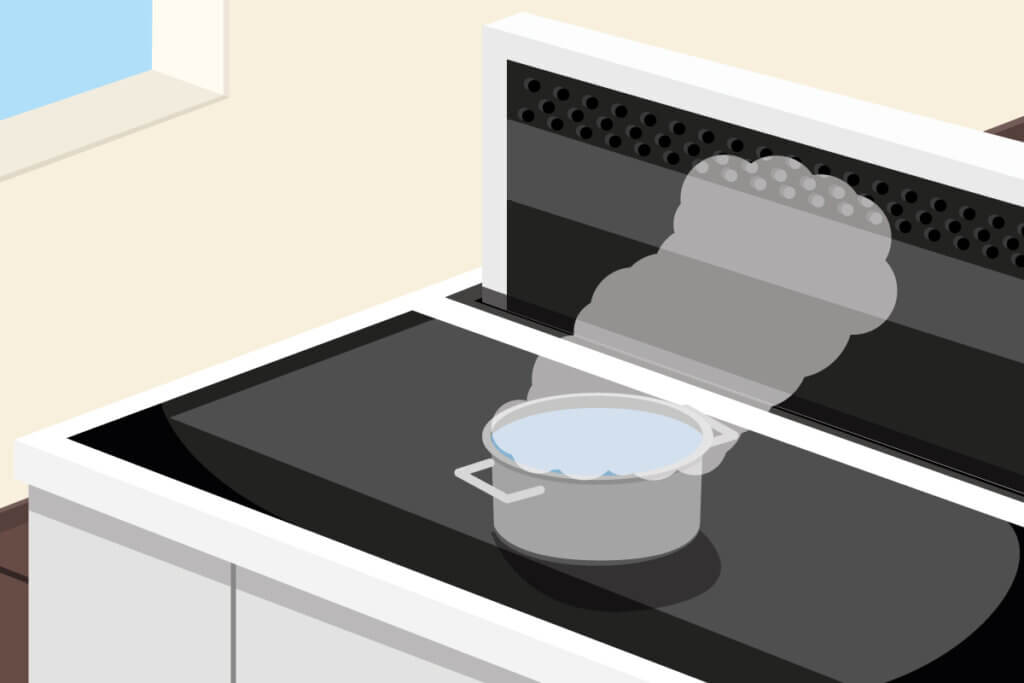
able fans are technically sophisticated and also an eye-catcher. When not in use, they are not visible as they are completely recessed into the cooking unit. When cooking, users simply extend the intake unit at the touch of a button. Many models allow the suction unit to be locked at different heights, so the ideal position can be set for any pan or pot height. The resulting vapor is then extracted from the side.
Features and equipment
When choosing the right cooker hood model, apart from the appearance and the type of fan, there are a few other points to consider when making a purchase decision. For example, the width, available fan speeds or the maximum air flow rate. We present important criteria below.
How wide should the cooker hood be?
A classic stove hood should be a little wider than the hob underneath it, so that the vapors are optimally extracted even in the presence of influences such as drafts and do not pass by the appliance. Only in this way is the full effect of the fume hood possible. If space is tight, prospective buyers should look for special models.
Air exchange rate determines performance
The so-called air exchange rate provides information on how many cubic meters of air are circulated or transported outside per hour. The value is usually indicated by the unit symbol m³. The air exchange rate should be approximately six to twelve times the volume of the kitchen. A cooker hood should therefore be able to exchange the air in the room as a whole this often within an hour or transport this amount of air outside.
Calculation example
You have a kitchen of 10 square meters and with a ceiling height of 2.50 meters. Multiplying the number of square meters by the ceiling height gives a kitchen volume of 25 cubic meters. If the range hood is to be capable of moving six to twelve times that volume in an hour, an air exchange rate of 150 to 300 cubic meters per hour is required.
Minimum diameter of the exhaust hose depends on air exchange rate
If you want to use your cooker hood in exhaust mode, you must make sure that the exhaust hose, which transports the fumes outside, has the minimum diameter required by the air exchange rate. Otherwise, the vapor may build up in the hose and cause humidity to rain down. This can damage the unit if used for a long period of time. In the following table we provide information about the minimum diameter of the hose depending on the air exchange rate.
| Air exchange rate | Diameter of the exhaust air hose |
| up to 300 m³/h | 100 mm |
| up to 500 m³/h | 125 mm |
| up to 800 m³/h | 150 mm |
| up to 1,800 m³/h | 200 mm |
Energy efficiency determines annual electricity costs
The EU energy label is mandatory for many electrical appliances, including cooker hoods. Among other things, it provides information on annual power consumption, airflow efficiency and noise levels. We present an example label for cooker hoods below.
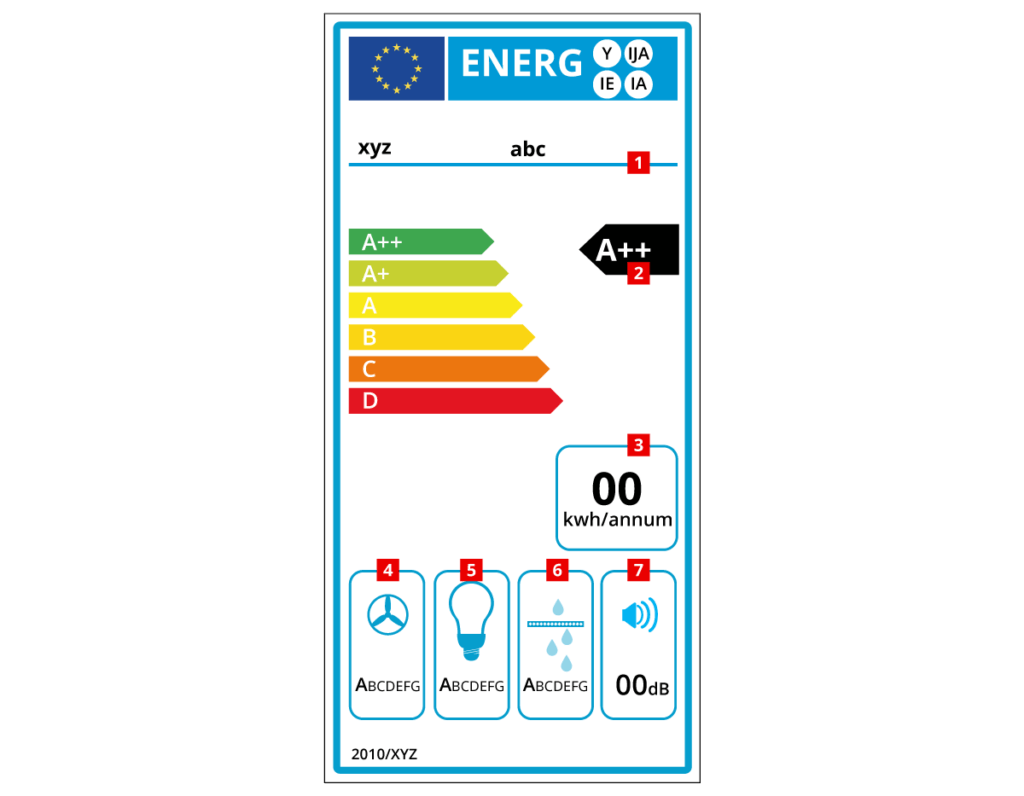
(1) Manufacturer name and model name.
(2) Energy efficiency class. Since 2018, particularly economical appliances can also bear an A+++ label. According to this new classification, “E” is the most inefficient energy class.
(3) Energy consumption in kilowatt hours (kWh). Calculation basis: daily one hour operation in fume hood mode, two hours operation in lighting mode.
(4) Air handling efficiency: scale from A (best) to G (worst).
(5) Lighting efficiency: scale from A (best) to G (worst).
(6) Grease separation efficiency: scale from A (best) to G (worst).
(7) Noise level in decibels (dB) at highest setting for normal use.
Cooktop lighting: Conjuring up dishes at any time of day
Just about all range hoods also have a built-in light source that illuminates the cooktop. In the case of newer models, these are now LEDs, which are particularly energy-saving and at the same time pleasantly bright. Halogen spotlights are still popular, however, as they produce a warmer light that some people find more pleasant. No longer widely used and only installed in older kitchens are range hoods with comparatively cold-looking fluorescent lighting. Illuminants that are mounted all around illuminate the entire cooktop better than those that are placed only at the front or back of the hoods. Different brightness levels or even a dimming function provide the ideal brightness. However, many models only know on and off in this respect.
Operating concept: Switching on and regulating
The classic way of operating a cooker hood: there are mechanical buttons for switching on and off and for selecting the level of the fan function, as well as for switching the lighting on and off. In models that users pull out or flip open, pulling out or flipping open, respectively, is often enough for the previously selected level and the lighting to turn itself on and off. You can operate these mechanisms without problems even with wet or greasy fingers. Touch control surfaces look more elegant and are easier to clean, but it is sometimes difficult or even impossible to operate them with fingers that are dirty from cooking. In this case, washing and drying your hands is the only solution. In the upper class, prospective buyers have a choice of models that come with remote control or even allow control via app from a smartphone or tablet.
Practical extras for demanding users
Some manufacturers equip their models with a range of practical additional functions. We present a selection of them.
Automatic run-on
The automatic after-run function comes in handy when you’ve finished cooking and want to eat, but are unhappy with the amount of fumes or smoke in the kitchen. At the touch of a button, you activate the fume hood, which automatically shuts off either after a fixed time – about 15 minutes – or after a freely selectable period of time.
Intensive stage
Many manufacturers equip their models with an intensive stage (also called powerBoost function by some manufacturers), which can be switched on via a special button (Siemens, Miele, AEG, Neff, Bomann, Klarstein and Bosch). It is intended for briefly switching on when there is a strong surge of fumes, for example when sautéing. Some models automatically switch back to the previously selected level after a certain period of time.
Interval ventilation
Once activated, this function circulates the room air at the lowest level for five minutes every hour around the clock. The function is also called 24-hour air circulation or continuous ventilation function by some manufacturers. Such solutions can be found in models from Bosch, Gaggenau, Neff and Siemens, for example.
Sensor automatic
Sensor automation is a convenience feature on high-priced range hood models. Ultrasonic and air quality sensors monitor the amount of fumes and odor molecules in the ambient air and regulate the fume hood fully automatically if necessary. Once the cooking process is finished, the units switch off automatically after an automatic run-on phase.
Cleaning and care
You should regularly check, clean and, if necessary, replace activated charcoal and grease filters. We explain below what you should definitely pay attention to and how to clean and care for your appliance.
Activated carbon filter
The activated charcoal filter has the task of removing unpleasant odors from cooking vapors. If it smells of grease even though the recirculation hood is on, the activated charcoal is used up. The life of the filter depends on how often you cook and how much you use it. With average use, this occurs after six to twelve months. Then users need to remove and dispose of the filter and install a new one. But there are ways to make the filter fit again.
Regenerating activated carbon filters
Some activated carbon filters can “regenerate” themselves. Whether this is possible should be listed in the description of the filter. If in doubt, do not attempt regeneration. You can put models that support this feature in the oven at 200 degrees for two hours. Then all residues will be removed and the filter can be used again. If you repeat this procedure every four months, as recommended, the useful life of a filter increases to seven to ten years. The required oven temperature as well as the exposure time may vary depending on the type of filter. It is recommended to ventilate the kitchen during the process, otherwise odors may develop.
Refill activated carbon filter yourself
If you want to save money, you can refill the used activated carbon filter yourself. To do this, you will need activated carbon pellets or granules. However, you will need to open the filter – a task that requires some prior knowledge and skill. If you make a mistake when refilling, the recirculation hood may no longer work properly. Therefore, this method is rather not recommended for the average user.
Order replacement filters online
Provided that the model name is known, you can save a lot of money by ordering a larger quantity of the filters on the Internet. Compared to buying a small pack in a retail store, big discounts are possible.
Metal filter
The metal filter removes fats and oils from cooking and frying fumes. However, over time, the grease settles on the metal struts and reduces the passage for the vapor. Then it is high time to clean the filter. Not only because the function of the cooker hood is otherwise limited, but also because a greasy metal filter poses an increased fire hazard. Opinions differ on how often the filter should be cleaned. A wide variety of recommendations can be found on the Internet. Some of them are not very realistic for private households, such as the advice to clean the filter at least every 14 days. In the following table, we have compiled which cleaning frequency is recommended for which intensity of use.
| Intensity of use | Cleaning frequency |
| High usage (catering) | Every 7 to 14 days |
| Normal cooking (home) | Every 4 to 12 weeks |
| Infrequent use (second home, hardly any cooking) | Every 3 to 6 months |
Cleaning the metal filter
Cleaning of the metal filter is possible after a soaking time by hand (with warm water, detergent and a dishwashing brush) and also in the dishwasher (intensive program). You can soak heavily soiled filters in an alkaline kitchen cleaner beforehand.
Cleaning the surfaces
If the surfaces of the cooker hood need to be cleaned, for example because grease and oil have settled or fingerprints are visible, proceed as follows:
- First, allow the lamps to cool down completely. It should be noted that halogen lamps become particularly hot.
- Wipe the surfaces with warm water and washing-up liquid. When doing so, make sure that as little water as possible gets into the openings of switches so as not to damage the cooker hood.
- You should avoid using hard sponges and scouring agents, as these can damage the surfaces.

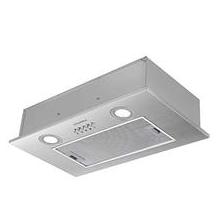
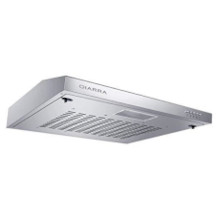
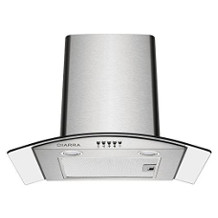



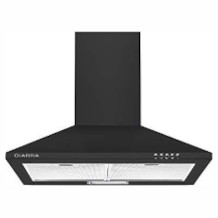
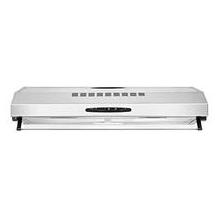
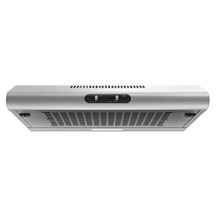

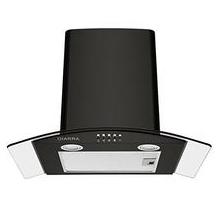

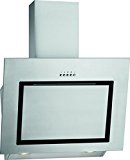
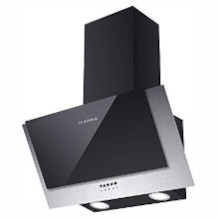
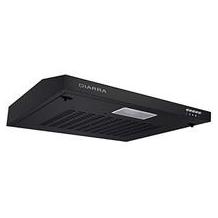

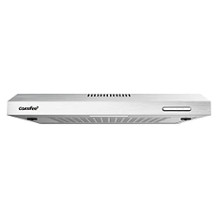

 115 reviews
115 reviews
